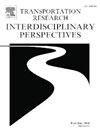Assessing the driving forces of carbon dioxide emissions of the transport sector in Central Europe
IF 3.9
Q2 TRANSPORTATION
Transportation Research Interdisciplinary Perspectives
Pub Date : 2025-04-21
DOI:10.1016/j.trip.2025.101428
引用次数: 0
Abstract
The transportation sector in Central Europe, encompassing Hungary, Poland, the Czech Republic, Slovakia, and Austria, has emerged as a significant contributor to CO2 emissions, posing a critical challenge to the region’s climate goals. This study addresses the urgent need to understand the driving forces behind these emissions from 2001 to 2021, employing the Kaya identity and Logarithmic Mean Divisia Index (LMDI) method to decompose the changes into GDP growth, energy intensity, carbon intensity, and population effects. The analysis reveals that GDP growth, particularly in Poland and Slovakia, has been the dominant factor driving the increase in CO2 emissions. However, the study also identifies successful reductions in energy and carbon intensity in Austria and Hungary, partially offsetting the emissions growth linked to their economic expansion. Despite these advancements, the slow transition to cleaner energy in Poland and Slovakia highlights the need for more aggressive policies. The minimal impact of population changes on emissions further underscores the importance of focusing on energy efficiency and renewable energy adoption. The findings suggest that to achieve substantial CO2 reductions, Central European countries must implement targeted strategies tailored to their specific conditions. Future research should explore next-generation battery technologies, hydrogen fuel cells for heavy-duty transport, and integrating renewable energy in transportation systems. The implications of this work point to the necessity of a concerted effort in policy innovation and technological development to ensure a sustainable transportation future in Central Europe.
评估中欧运输部门二氧化碳排放的驱动力
中欧地区(包括匈牙利、波兰、捷克共和国、斯洛伐克和奥地利)的交通部门已成为二氧化碳排放的重要贡献者,对该地区的气候目标提出了严峻挑战。本研究针对了解 2001 年至 2021 年这些排放背后驱动力的迫切需求,采用卡亚特性和对数平均分维西亚指数(LMDI)方法,将变化分解为 GDP 增长、能源强度、碳强度和人口效应。分析表明,国内生产总值的增长,尤其是波兰和斯洛伐克的国内生产总值的增长,是推动二氧化碳排放量增加的主要因素。不过,研究也发现奥地利和匈牙利成功降低了能源和碳强度,部分抵消了与经济扩张相关的排放量增长。尽管取得了这些进步,但波兰和斯洛伐克向清洁能源过渡的速度缓慢,这凸显了制定更积极政策的必要性。人口变化对排放的影响微乎其微,这进一步强调了关注能源效率和可再生能源采用的重要性。研究结果表明,要实现二氧化碳的大幅减排,中欧国家必须根据其具体情况实施有针对性的战略。未来的研究应探索下一代电池技术、用于重型运输的氢燃料电池以及将可再生能源纳入运输系统。这项工作的影响表明,有必要在政策创新和技术发展方面共同努力,以确保中欧未来交通的可持续发展。
本文章由计算机程序翻译,如有差异,请以英文原文为准。
求助全文
约1分钟内获得全文
求助全文
来源期刊

Transportation Research Interdisciplinary Perspectives
Engineering-Automotive Engineering
CiteScore
12.90
自引率
0.00%
发文量
185
审稿时长
22 weeks
 求助内容:
求助内容: 应助结果提醒方式:
应助结果提醒方式:


